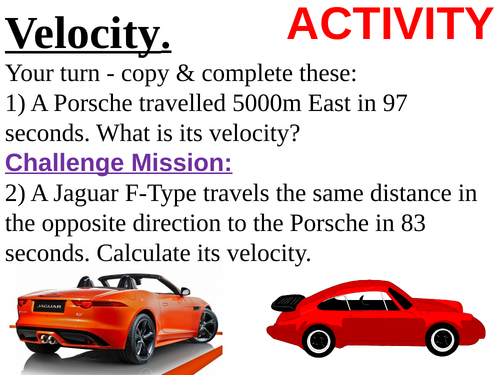





A complete, KS4 / GCSE lesson (
* Explain the difference between scalars and vectors.
* Name all the important scalars and vectors.
* Successfully complete a practical experiment on vectors/scalars.
* Successfully calculate speed, velocity, distance and time using the speed equation.
This carefully crafted lesson is over 40 slides long, and is full of learning activities as below:
* Notes to help the teacher.
* Starter - unscramble the words.
* Starter - simple task where students self-assess against the objectives.
* Activity sheet (unique - not available anywhere else) - simply print for each student.
* Practical / student experiment.
* Questions (with differentiation) – all answers are provided.
* Peer marking
* Self marking
* Theory slides (carefully sculpted, interspaced with learning activities, not ‘death by powerpoint’).
* Play ball.
* Paired work activities – all answers are provided.
* Homework worksheet (unique)
* Scientific Numeracy activities.
* Student self-assessment versus objectives activity – so learners can judge for themselves how much they have learnt.
As teachers we all work ridiculously long hours each week. Give yourself a break, spend some life with your wife / husband / children / friends / family by purchasing more lessons created by “Barclayfox” once they appear on TES.
Please note: when searching for resources please type barclayfox into the search box/engine and it will show you all our resources.
Please purchase this lesson, and leave a positive review.
This lesson is part of a series, whilst they all work very well as standalone individual lessons you may wish to buy others from the series:
0. Bundles – contain 3 or more of these lessons at a discounted price (however please note not all my series are bundled).
1. Vectors and scalars.
2. Forces between objects (contact / non-contact and Newton’s 3rd law).
3. Forces and Newton’s third law (N3L).
4. Resultant forces, free body diagrams.
5. Forces and acceleration F=Ma
6 to 12 - please see list in this powerpoint
Here is the next lesson in the series:
https://www.tes.com/teaching-resource/forces-between-objects-contact-and-non-contact-forces-and-force-fields-complete-lesson-11728381
Happy teaching!
Yours,
Barclayfox.
* Explain the difference between scalars and vectors.
* Name all the important scalars and vectors.
* Successfully complete a practical experiment on vectors/scalars.
* Successfully calculate speed, velocity, distance and time using the speed equation.
This carefully crafted lesson is over 40 slides long, and is full of learning activities as below:
* Notes to help the teacher.
* Starter - unscramble the words.
* Starter - simple task where students self-assess against the objectives.
* Activity sheet (unique - not available anywhere else) - simply print for each student.
* Practical / student experiment.
* Questions (with differentiation) – all answers are provided.
* Peer marking
* Self marking
* Theory slides (carefully sculpted, interspaced with learning activities, not ‘death by powerpoint’).
* Play ball.
* Paired work activities – all answers are provided.
* Homework worksheet (unique)
* Scientific Numeracy activities.
* Student self-assessment versus objectives activity – so learners can judge for themselves how much they have learnt.
As teachers we all work ridiculously long hours each week. Give yourself a break, spend some life with your wife / husband / children / friends / family by purchasing more lessons created by “Barclayfox” once they appear on TES.
Please note: when searching for resources please type barclayfox into the search box/engine and it will show you all our resources.
Please purchase this lesson, and leave a positive review.
This lesson is part of a series, whilst they all work very well as standalone individual lessons you may wish to buy others from the series:
0. Bundles – contain 3 or more of these lessons at a discounted price (however please note not all my series are bundled).
1. Vectors and scalars.
2. Forces between objects (contact / non-contact and Newton’s 3rd law).
3. Forces and Newton’s third law (N3L).
4. Resultant forces, free body diagrams.
5. Forces and acceleration F=Ma
6 to 12 - please see list in this powerpoint
Here is the next lesson in the series:
https://www.tes.com/teaching-resource/forces-between-objects-contact-and-non-contact-forces-and-force-fields-complete-lesson-11728381
Happy teaching!
Yours,
Barclayfox.
Something went wrong, please try again later.
Excellent, thank you. I recommend this!
Report this resourceto let us know if it violates our terms and conditions.
Our customer service team will review your report and will be in touch.
£3.99